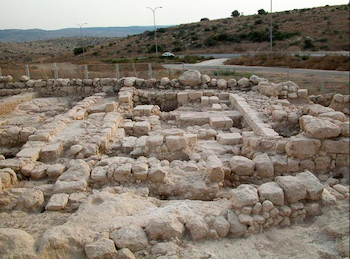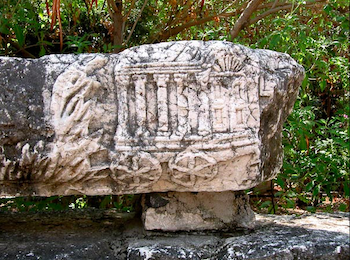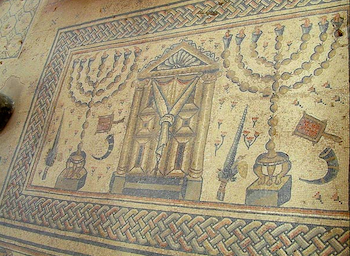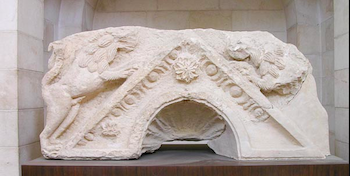See Also: What did a Synagogue of Jesus' Time look like?
By Paul V.M. Flesher
Director
Religious Studies Program
University of Wyoming
September 2011
For nearly the entire first millennium BC, Judaism worshipped God by offering sacrifices in the Temple at Jerusalem. This was in keeping with the Torah, which contained the oldest books of the Hebrew Bible (a.k.a. the Christian Old Testament). King Herod thought the Temple was so important he rebuilt it to rival the religious shrines Caesar built in Rome. Jesus, his disciples, and Paul worshipped in Herod's architectural marvel.
But in the first century AD, the Romans were often disrespectful of the Jerusalem Temple and the Jews' monotheistic beliefs. After decades of provocation, the Jews rebelled against the Empire in 66 AD; four years later the Roman army destroyed Jerusalem and its Temple. After two generations without the Temple, a new group of rebellious patriots tried to regain Jerusalem under the leadership of Simon bar Kokhba ("Simon son of the Star"). The Romans crushed them in 135 and banned Jews not only from entering Jerusalem but from living in the surrounding territory of Judea.
Since that time, Judaism has had no Temple and, until the twentieth century, was without access to Jerusalem. The religion should have died out. Every other temple-based religion around the Mediterranean Sea did. Indeed, Judaism is the only Mediterranean religion that was practiced in 50 BC that still flourished in 500 AD.
How did Judaism manage not just to survive but to thrive? The answer lies in the religious institution that replaced the Temple, namely, the synagogue. Rather than a single Temple towards which all Jews looked (most from afar), synagogues arose in villages, towns and cities, everywhere enough Jews lived to support one. Ancient synagogues are known all across the Mediterranean world, as well as in Europe, the lands around the Black Sea, and modern-day Iraq. But it is the Palestinian synagogues, primarily those in Galilee, that provide the main evidence for Judaism's transformation from a Temple-based sacrificial religion into a spiritually oriented faith which drew its religious beliefs and practices from a reverence for and knowledge of Scripture.
Prior to the destruction of Jerusalem and its Temple in 70, the synagogue did not seem to be a likely candidate to become Judaism's central institution. In last month's essay, "What did a synagogue in Jesus' time look like?" I described how the archaeological remains of synagogues in first-century villages in the Land of Israel were rather featureless. In Gamla, Qiryat Sefer, Magdala and Modi'in, there are remains of public buildings that have been identified as synagogues.[1] They are larger than private dwellings, with an open interior and roofs supported by two rows of pillars. [2] The inside of the rectangular or square room is usually surrounded by stone benches built against the walls. While the essay built this description on the basis of synagogues from first-century villages, the synagogues found in the First Rebellion's fortresses of Masada and Herodium also fit it.

Photo from Bibleplaces.com
The frustrating thing about these structures, from our modern standpoint, is that they have no identifying symbols. They not only lack religious imagery but Jewish symbols are absent as well. If they were not located in a Jewish village, archaeologists could not even have identified them as Jewish.
The first century Jewish historian Josephus occasionally mentions synagogues, lauding them for the way they help Jews learn their sacred scriptures. He says that "Moses our leader made the Law [i.e., Torah] the standard and rule, that we might live under it as under a father and master, and be guilty of no sin through wilfulness or ignorance."[3] Elsewhere he observes:
For ignorance [Moses] left no pretext. He appointed the Law [i.e., Torah] to be the most excellent and necessary form of instruction, ordaining, not that it should be heard [just] once for all or twice or on several occasions, but that every week men should desert their other occupations and assemble to listen to the Law and to obtain thorough and accurate knowledge of it….
The first-century synagogues excavated by archaeologists reveal no link to the Torah or its public reading. There is nothing specific in the structures that would indicate the importance of Torah or its use in worship. Of course the center of the room faced by the people sitting on the benches could have been used for Torah reading, but it could just as easily been used for speakers debating trash collection in a town meeting. The synagogue remains of the first century do not foreshadow this institution's importance in post-Temple Judaism.
The Temple's destruction ushered in what Lee Levine called the two-hundred year hiatus in synagogue remains.[4] When Levine wrote in 2000, there was no fully published evidence of any second-century synagogues. (We will discuss new evidence concerning this 200-year gap below.) Indeed, in 2000, the earliest known synagogue remains from Palestine after 70 belonged to the late third century; most synagogue remains stem from the fourth-sixth centuries century.[5] Most of these are in Galilee, but others appear in the Jordan Valley and southern Judea.
Nearly all of these later synagogue remains have features indicating that Scripture reading formed an important part of synagogue worship. They feature an apse, a niche, or shrine at one end of the main room upon which to read, display or house the Torah scrolls. At the fourth-century synagogue in Hammat Tiberias, this takes the form of a large, raised platform, built as a large, semi-circular platform on the wall opposite the monumental entrance.[6] At third-century Nabratein, archaeologists found the peaked gable that crowned a large stone Torah shrine.[7] While the fourth-century synagogue at Capernaum lacks this feature, archaeologists found a carved architectural stone displaying a wheeled wooden Torah shrine.
Wheeled Torah Shrine carving from Capernaum synagogue, 4th century CE or later.
Photo from Bibleplaces.com
Many of these synagogues also feature a bemah, a raised platform upon which the scrolls of scripture would have been displayed or read.[8]

synagogue, 4th century CE or later.
Photo from Bibleplaces.com
These new structural features in the synagogue show that by the late third or early fourth century the Torah had become an important element in synagogue worship. Indeed, it was important enough to alter the architectural design of the synagogue from its first century layout.
But the fourth century provides even better evidence for this transformation. Beginning with the Hammat Tiberias synagogue, there are more than a dozen excavated synagogues that have decorated mosaic floors. These include Beth Alpha, Sepphoris, Horvat Susiya, Bet Shean, Naaran, and Hammat Gader. Most of these floors feature a panel at the front, near the apse, that shows a box-like structure.[9]

Tiberias synagogue, 4th century CE.
Photo from Bibleplaces.com
The box-like object varies in detail, but it usually looks like a tall rectangle with two or three pillars and two closed doors. Often a curtain is associated with the object. The box is surmounted by a triangle within which appears a scallop-shaped, ribbed decoration (often called a conch shell) sometimes accompanied by a hanging lamp.[10] On some mosaic floors, this image is associated with lions, presumably a symbol for Judaism (after the Lion of Judah).
This assemblage has a double interpretation. On the one hand, it looks like a Torah shrine whose doors can open to reveal the scrolls stored within.[11] Indeed, it probably looks like the Torah shrine before which it is located. Although no physical remains of Torah shrines were found in synagogues with mosaic floors, the large fragment of a shrine found at the Nabratein synagogue fits this imagery.[12] On the other hand, the box image symbolizes the Jerusalem Temple. The pillars and doors present a monumental, temple-like façade, while the scallop image is a wide-spread symbol of sacred presence in antiquity. The lamp recalls the eternal flame of the Temple indicating God's presence.[13]

synagogue, 3rd-4th century CE.
Photo from Bibleplaces.com
The Temple/Torah Shrine image is accompanied on the mosaic panel by objects used in Jewish worship, like the lulab, etrog, incense shovel, the shofar made from a ram's horn, and two of the seven-branched candelabras known as menorahs. These were all originally part of Temple festivals or, in the case of the menorahs, part of the Temple's permanent furniture. By the fourth century, these objects have become part of the worship carried out in the synagogues, with the exception of the incense shovels.
So it is clear by the fourth century that the synagogue, unpromising as it may have been in the first century, has become the center for linking the absent Temple with the present Torah. Without going into detail in this brief essay, let me observe that the mosaics' identifying of Torah and Temple as one symbolizes the manner in which Torah reading, reverence, study and observance has become identified with Temple. Through the medium of the synagogue, the Torah provides a replacement for the long-past Temple worship. So in this sense, the synagogue "saved" Judaism after the Temple's destruction, providing a locus for new life and the religion's regeneration.
We could end this essay with this conclusion, but it is important to address briefly the problem of the 200-year gap in synagogue remains.
Why is there such a large gap? Levine lays out three explanations that have been put forward for this.[14] The first is that they were destroyed by earthquakes, conversions to pagan temples, or by wars of 70 and 135. A second, and Levine's favorite, is that evidence for them was destroyed during (re)building projects of the third, fourth and later centuries. Certainly some synagogues have remains of earlier structures underneath them which a few scholars claim might have been synagogues. Capernaum is an example of this. The third explanation is that synagogues were gatherings that met in the open air or in private homes, and so would leave no archaeological remains. This idea has been promoted by Howard Clark Kee.
It seems to me that these explanations overlook the obvious human impact of the destruction of Jerusalem in 70 and the banishment of the Jewish population from Judea in 135. That is, there would have been a massive refugee problem after 135 (after 70, most imprisoned Jerusalemites were sold as slaves). In the modern world we have governmental and non-governmental agencies that work to feed, house and cloth refugees, and to resettle them. There were no such organizations in antiquity. The disruption and poverty cause by such a refugee crisis would have gone on for decades after 135. This observation points also towards variation on the third explanation, since there would have been few resources to build synagogues.
Second, since the publication of Levine's study in 2000, excavators have identified two synagogues that may stem from the second century. Do they indicate any development towards the synagogue of the fourth century and its Torah links? The first of these is Horvat 'Ethri, located in the Judean Shephelah and excavated under the leadership of Boaz Zissu.[15] It was built in the decades following 70 and destroyed during the Bar Kokhba rebellion. Although not fully published, this synagogue is similar to the unadorned synagogues of the first century, although it lacks benches around the walls. Perhaps this was because of the economic hardship following the first Jewish rebellion against Rome. It shows no architectural elements to link it to Torah reading.
The second synagogue is that of the first stage of the Nabratein synagogue, located in the Upper Galilee, northwest of the Sea of Galilee. It was excavated by a team directed by Eric Meyers and published in 2009.[16] Meyers dates the earliest synagogue in this location to the first half of the second century. In general, it looks like first-century synagogues. Like the first-century synagogues, it is an unadorned, rectangular, public building, with columns supporting the roof and with stone benches built against the walls. At the south end, however, instead of benches, there are the remains of two, raised platforms. These platforms Meyers interprets as bemas, suggesting that one was used for Torah reading and the other for its display. If he is correct, then these provide the earliest archaeological indication of the Torah's place in the post-Temple synagogue. It puts Torah-related changes in synagogue architecture otherwise known only from the third century into a time nearly a century earlier.
So the synagogue as an institution helped Judaism transform itself into a non-temple religion by emphasizing the importance of the Hebrew Bible, ultimately linking it with the now-absent Temple. This transformation can certainly be observed from the mid-third century onwards, and takes on its fullest form in the mosaics of the fourth century and later. If Eric Meyers is correct in his interpretation of the Nabratein excavations, then that transformation began almost as soon as the Temple was destroyed, certainly within a generation or two.
Notes
[1] For a discussion of Gamla and pre-70 synagogues not located in villages, see my "Palestinian Synagogues before 70 C.E. A Review of the Evidence," pp. 27-39 in Ancient Synagogues: Historical Analysis and Archaeological Discovery (Leiden: Brill, 1995). The more recently discovered sites have yet to receive full publication. For Qiryat Sefer, see http://www.mfa.gov.il/MFA/History/Early%20History%20-%20Archaeology/Kiryat%20Sefer%20-%20A
%20Synagogue%20in%20a%20Jewish%20Village%20of. For Modiin (=Khirbet Umm el-Umdan), see http://www.antiquities.org.il/article_Item_eng.asp?sec_id=36&subj_id=68&id=228&module_id=#as. For Magdala (=Migdal), see http://www.mfa.gov.il/MFA/Israel+beyond+politics/Unique-ancient-synagogue-exposed-at-Sea-of-Galilee-14-SEP-2009.
[2] The Magdala synagogue finds, which have yet to be described even in a preliminary report, are quite unusual for a first-century synagogue. They not only evidence a white mosaic floor, but the excavators found a carved stone block showing a menorah. The archaeologist's claim for a first century dating set this menorah earlier than any other menorah image in a public Jewish building by almost two centuries. (See Levine, Ancient Synagogue, below, p. 182, as well as Levine "The history and Significance of the menorah in Antiquity," in From Dura to Sepphoris: Studies in Jewish Art and Society in Late Antiquity, Lee I. Levine and Zeev Weiss, eds., JRA Supplementary Series 40 [Portsmouth, RI: Journal of Roman Archaeology, 2000], pp. 131-153.) Moreover, the style is quite similar to the fourth-century carved stone blocks found at Capernaum. I will reserve judgment about this synagogue's date until more complete publication.
[3] Josephus, Against Apion, II:174, 174. Translation by H. St. J. Thackeray, Josephus: The Life, Against Apion (Cambridge, MA: Harvard University Press, 1926 (1976)).
[4] Lee I. Levine, The Ancient Synagogue: The First Thousand Years (New Haven, CT: Yale University Press, 2000), pp. 168-9.
[5] Jodi Magness has questioned the dating of several synagogues assigned to the third century. See her analysis of the synagogues of Gush Halav and Capernaum (as well as responses to her analysis) in Judaism in Late Antiquity: Part Three: Where We Stand: Issues and Debates in Ancient Judaism, volume 4, The Special Problem of the Synagogue (Leiden: Brill, 2001). See also Magness's, "Synagogue Typology and Earthquake Chronology at Khirbet Shema', Israel" in Journal of Field Archaeology 24:2 (1997): 211-220, as well as her discussion of Nabratein mentioned below.
[6] Moshe Dothan, Hammath Tiberias: Early Synagogues and the Hellenistic and Roman Remains (Jerusalem: Israel Exploration Society, 1983).
[7] See the references to Meyers in footnote 12.
[8] See the discussion in Lihi Habas, "The bema and chancel screen in synagogues and their origin," in From Dura to Sepphoris, pp. 111-130.
[9] This is often accompanied by a zodiac image. Both of these images, as well as others appearing on synagogue mosaic floors of the fourth to sixth century, have been widely discussed in the scholarly literature. For a recent collection of essays on them that includes bibliography, see From Dura to Sepphoris.
[10] Much of this imagery appears directly on the Torah Niche at the third-century Dura Europos synagogue, which was destroyed in 256. See Carl H. Kraeling, The Synagogue (New Haven, CT: Yale University Press, 1956), as well as Erwin R. Goodenough, Jewish Symbols in the Greco-Roman World (New York: Bollingen Foundation & Pantheon Books, 1964), volumes 9-11.
[11] Versions of this image can be found in contexts outside the synagogue, as evidenced by its appearance on a gold glass vessel from the Roman catacombs dating to the third to fifth century. In this depiction, the doors are partly open to reveal the scrolls within. See Lee I. Levine, "The history and significance of the menorah in antiquity," pp. 131-153 in From Dura to Sepphoris, esp. p. 146, Fig. 82.
[12] See Eric M. Meyers, James F. Strange and Carol L. Meyers, "The Ark of Nabratein: A First Glance," Biblical Archaeologist 44:4 (1981): 237-243; as well as Eric M. Meyers and Carol L. Meyers, Excavations at Ancient Nabratein: Synagogue and Environs. Meiron Excavation Project VI (Winona Lake, IN: Eisenbrauns, 2009), pp. 33-101, especially John G. Younger's discussion of "Architectural Elements and Sculptures," pp. 78-92.
[13] Capernaum's "Torah Shrine on wheels" exhibits some of these features. It looks like a temple, but it cannot be since it is on wheels.
[14] See Levine, Ancient Synagogue, pp. 168-172.
[15] See Boaz Zissu, "Horvat 'Ethri: a Jewish village from the Second Temple period and the Bar Kokhba revolt in the Judean foothills," Journal of Jewish Studies 60:1 (2009):90-136.
[16] See Meyers and Meyers, Ancient Nabratein, as well as Meyers, Strange and Meyers, "Ark of Nabratein." Jodi Magness questioned this early dating in her review of the dig report: "The Ancient Synagogue at Nabratein," BASOR 358 (2010): 61-68. Meyers and Meyers responded in "Response to Jodi Magness's Review of the Final Publication of Nabratein," in BASOR 359 (2010): 67-76 as well as in Eric M. Meyers, "The Problem of the Scarcity of Synagogues from 70 to ca. 250 C.E.: The Case of Synagogue 1 at Nabratein (2nd-3rd Century C.E.)," pp. 435-448 in Z. Weiss et al. eds, "Follow the Wise": Studies in Jewish History and Culture in Honor of Lee I. Levine (Winona Lake, WI: Eisenbrauns, 2010).
